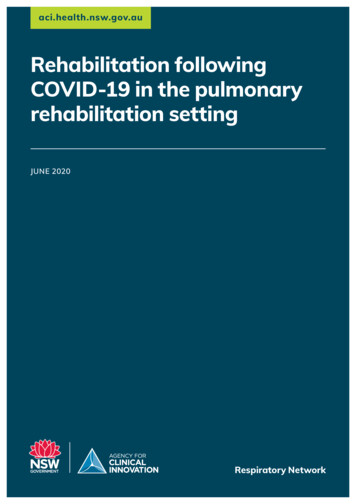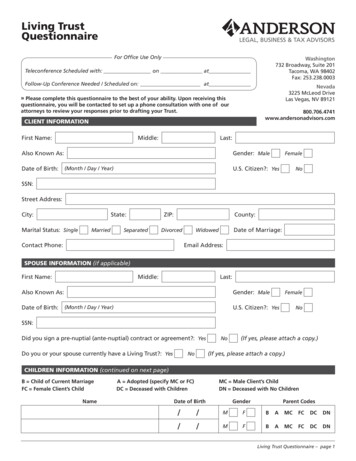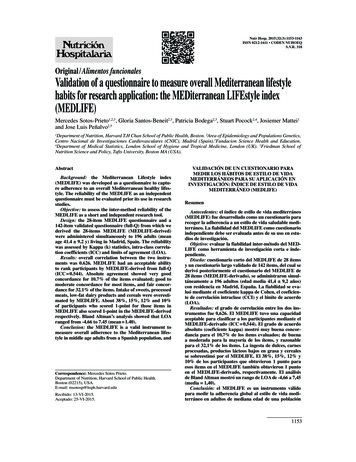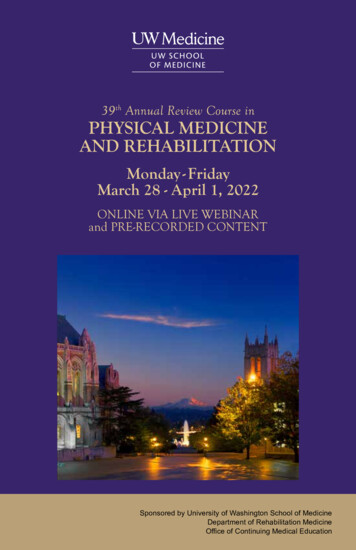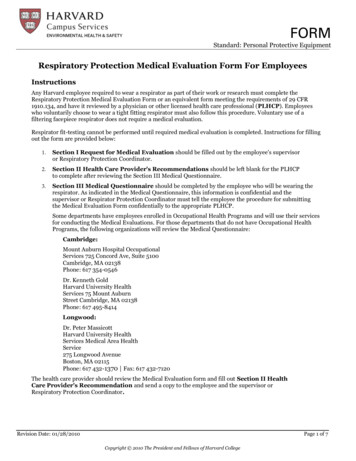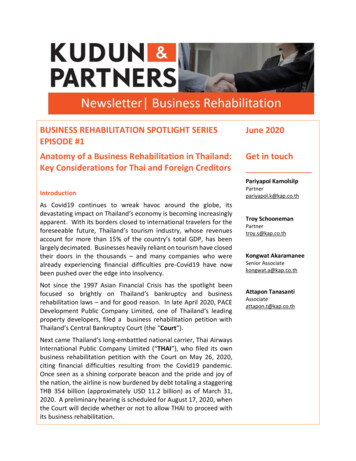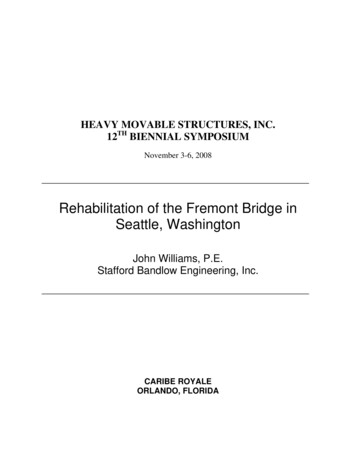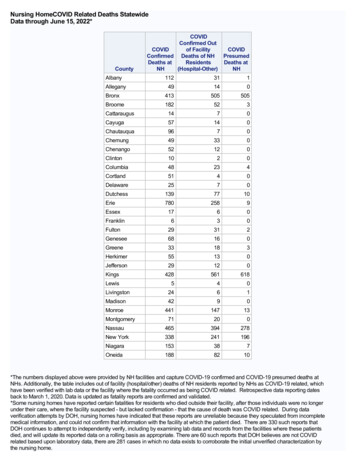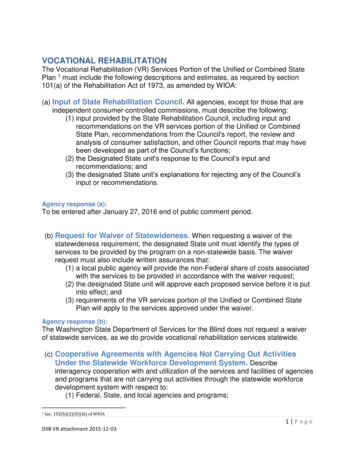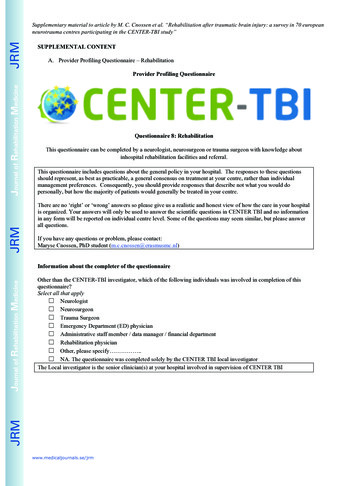
Transcription
JRMSupplementary material to article by M. C. Cnossen et al. “Rehabilitation after traumatic brain injury: a survey in 70 europeanneurotrauma centres participating in the CENTER-TBI study”SUPPLEMENTAL CONTENTA. Provider Profiling Questionnaire – RehabilitationJRMJournal of Rehabilitation MedicineProvider Profiling QuestionnaireQuestionnaire 8: RehabilitationThis questionnaire can be completed by a neurologist, neurosurgeon or trauma surgeon with knowledge aboutinhospital rehabilitation facilities and referral.This questionnaire includes questions about the general policy in your hospital. The responses to these questionsshould represent, as best as practicable, a general consensus on treatment at your centre, rather than individualmanagement preferences. Consequently, you should provide responses that describe not what you would dopersonally, but how the majority of patients would generally be treated in your centre.There are no ‘right’ or ‘wrong’ answers so please give us a realistic and honest view of how the care in your hospitalis organized. Your answers will only be used to answer the scientific questions in CENTER TBI and no informationin any form will be reported on individual centre level. Some of the questions may seem similar, but please answerall questions.If you have any questions or problem, please contact:Maryse Cnossen, PhD student (m.c.cnossen@erasmusmc.nl)Other than the CENTER-TBI investigator, which of the following individuals was involved in completion of thisquestionnaire?Select all that apply Neurologist Neurosurgeon Trauma Surgeon Emergency Department (ED) physician Administrative staff member / data manager / financial department Rehabilitation physician Other, please specify . NA. The questionnaire was completed solely by the CENTER TBI local investigatorThe Local investigator is the senior clinician(s) at your hospital involved in supervision of CENTER TBIJRMJournal of Rehabilitation MedicineInformation about the completer of the questionnairewww.medicaljournals.se/jrm
In-hospital care1.What rehabilitation facilities are available at your institutionSelect all that apply The hospital does not have an inhospital rehabilitation ward to which patients can be admitted for clinicalrehabilitation The hospital has a rehabilitation unit where TBI patients can be referred to after Intensive Care Unit (ICU)or ward admission The hospital has structural connections with rehabilitation settings outside the hospital; patients arereferred after Intensive Care Unit (ICU) or ward admission The hospital has an outpatient rehabilitation facility Other, please specify .Please note: When responding to this question, the term “rehabilitation facility” refers to a full multi-disciplinaryrehabilitation service, not isolated physiotherapy provision2. Can you consult rehabilitation specialists (e.g. physical therapists, occupational therapists, dieticians,psychologists, psychiatrists, rehabilitation physicians, speech therapists, social workers, nurses) for patients in yourIntensive Care Unit (ICU) or hospital ward?Select all that applyICUHospital wardNo We can consult rehabilitation specialists on an individual basisWe can consult a multidisciplinary rehabilitation team2b. if the second and/or third option is ticked: what rehabilitation disciplines are available to treat patients in yourIntensive Care Unit (ICU) or acute hospital ward?Select all that applyPhysical therapistOccupational therapistDietician(Neuro-) psychologistPsychiatristRehabilitation physicianSpeech therapistSocial workerNurseOther, please specify . ICU Hospital ward JRMJournal of Rehabilitation MedicineJRMJournal of Rehabilitation MedicineJRMSupplementary material to article by M. C. Cnossen et al. “Rehabilitation after traumatic brain injury: a survey in 70 europeanneurotrauma centres participating in the CENTER-TBI study”J Rehabil Med 49, 2017
2c. If a rehabilitation physician is available (if this box is ticked)When is the rehabilitation physician consulted?ICUo In every patiento The rehabilitation physicianis consulted on indication(not standard)What is the task of the rehabilitation physician?Select all that applyICU Triage (where should thepatient be referred to) Making a treatment planfor initial in-hospitalrehabilitation Part of multidisciplinaryconsultation (determiningtreatment policy) Not definedHospital wardo In every patiento The rehabilitation physicianis consulted on indication(not standard)Hospital ward Triage (where should thepatient be referred to) Making a treatment planfor initial in-hospitalrehabilitation Part of multidisciplinaryconsultation (determiningtreatment policy) Not defined3. Are acute medical rehabilitation guidelines or protocols used for patients with Traumatic Brain Injury (TBI) atthe Intensive Care Unit (ICU) or the acute hospital ward?o No. we do not have acute rehabilitation guidelines regarding TBI patientso Yes, we have acute rehabilitation guidelines for TBI patientsIf you do not know the answer to this question yourself, please contact the rehabilitation facility in your hospital3b. If yes: can you provide us your protocol as pdf / internet link4. Is coma stimulation (for example pharmacological, neurophysiological or psychological stimulation) used incomatose Traumatic Brain Injury (TBI) patients?o Noo Yes4b. If yes: What kind of stimulations are used?Select all that apply Pharmacologic stimulation Sensory stimulation (Visual, auditory, touch, smell, taste) Mobility stimulation (movement, position) Other, please specify .JRMJournal of Rehabilitation MedicineJRMJournal of Rehabilitation MedicineJRMSupplementary material to article by M. C. Cnossen et al. “Rehabilitation after traumatic brain injury: a survey in 70 europeanneurotrauma centres participating in the CENTER-TBI study”www.medicaljournals.se/jrm
Referral5. Where are Traumatic Brain Injury (TBI) patients with the following clinical characteristics generally referred to?You can select multiple centres here, but only select those that are part of your general policy. For example if youalways refer a particular patient group to a rehabilitation centres and some exceptions to a nursing home, only tickrehabilitation centre here.If approximately 70% of the patient in the particular category is referred to a rehabilitation centre and the other 30%to an outpatient rehabilitation facility, you can select both.The response that you provide should represent, as best as practicable, a general consensus on treatment at yourcentre, rather than individual thoughts or preferences.Select all that applyRehabilitationcentreNursinghomePsychiatric hospitalOutpatient rehabfacilitiesGeneralpractitioner /HealthCentreLocal atient, notobeyingcommands Elderlypatient ( 65)not obeyingcommands Youngpatientsobeyingcommandsbut still inPTA and withseverebehavioralproblems Elderlypatients ( 65)obeyingcommandsbut still inPTA and withseverebehavioralproblems Non-nativelanguagespeakingpatients JRMJournal of Rehabilitation MedicineJRMJournal of Rehabilitation MedicineJRMSupplementary material to article by M. C. Cnossen et al. “Rehabilitation after traumatic brain injury: a survey in 70 europeanneurotrauma centres participating in the CENTER-TBI study”J Rehabil Med 49, 2017
6. Where are Traumatic Brain Injury (TBI) patients without a health care insurance generally referred to?Select all that apply. N/A in our country (everyone has a health care insurance) Not important in the referral decision Rehabilitation centre Nursing home Psychiatric hospital Outpatient rehabilitation facilities General practitioner / Health centre Local / Regional Hospital Coma Care Other, please specify .7. Do you have the possibility to refer unconscious or minimally responsive patients to settings with comastimulation programs?o Noo Yes8. Does patients’ age have a major influence on referral decisions?o Noo YesIf yes: How? .The responses to this question should represent, as best as practicable, a general consensus on treatment at yourcentre, rather than individual management preferences.9. Approximately, what is the average waiting time for realization of discharge to referral institutes?With waiting time we mean the time between the moment that the patient is ready to be discharged from the hospitaland the time he/she is admitted or first visits the referral institutes. The waiting time probably varies per patient,geographic location and also varies over time. Please give us an estimate over the last year here.Within afew daysWithinoneweekWithinonemonth onemonth threemonths sixmonthsRehabilitation centreNursinghomePsychiatrichospitalOutpatient rehabfacilitiesGeneralpractitioner / HealthCentreLocal /RegionalHospitalComacareOther institution werewe refer TBIrehabilitation patientsto, please specify . JRMJournal of Rehabilitation MedicineJRMJournal of Rehabilitation MedicineJRMSupplementary material to article by M. C. Cnossen et al. “Rehabilitation after traumatic brain injury: a survey in 70 europeanneurotrauma centres participating in the CENTER-TBI study”www.medicaljournals.se/jrm
10. Are any of the following factors important for the acceptance policy of rehabilitation institutes?NoYes Uninsured patient Patients are less often referred to a rehabilitation centrePatients are more often referred to a nursing homePatients are more often referred home / to the GPFollow-up appointments in the hospital are less oftenscheduled Other, pleasespecify Illegal foreigner Patients are less often referred to a rehabilitation centrePatients are more often referred to a nursing homePatients are more often referred home / to the GPFollow-up appointments in the hospital are less oftenscheduled Other, pleasespecify Legal foreigner Patients are more often referred to a nursing home Patients are more often referred home / to the GP Follow-up appointments in the hospital are less often scheduled Other, pleasespecify The responses to this question should represent, as best as practicable, a general consensus on treatment at yourcentre, rather than individual thoughts.11. Information communication between acute care providers and rehabilitation facilities is generally by:Select all that apply Personal interaction (telephone or otherwise) Sending full medical report and images Access to reports via a shared region wide patient management system Discharge letterJRMJournal of Rehabilitation MedicineIf yes, how does it influence rehabilitation policySelect all that apply Patients are less often referred to a rehabilitation centre Patients are more often referred to a nursing home Patients are more often referred home / to the GP Follow-up appointments in the hospital are less oftenscheduled Other, pleasespecify Non-native languagespeaking patientJRMJournal of Rehabilitation MedicineJRMSupplementary material to article by M. C. Cnossen et al. “Rehabilitation after traumatic brain injury: a survey in 70 europeanneurotrauma centres participating in the CENTER-TBI study”J Rehabil Med 49, 2017
Journal of Rehabilitation MedicineJRMSupplementary material to article by M. C. Cnossen et al. “Rehabilitation after traumatic brain injury: a survey in 70 europeanneurotrauma centres participating in the CENTER-TBI study”12. Is there a form of coordination or structured collaboration between your hospital and one or more rehabilitationinstitutes and/or nursing homes in your region?o Noo Yes13. Which factors are considered in deciding on rehabilitation choice for a patient? Please rank the following factorsfrom most to least important (1 to 5) Quality of care1. . Distance to patients home2. . Availability at short notice3. . Specialized neuro-rehabilitation4. . Funding / financial reason5 The responses to this question should represent, as best as practicable, a general consensus in your center.14. Please rank the satisfaction of your team on how these factors are met in your network (1 not satisfied at all – 5completely satisfied). Quality of care(1, 2, 3, 4, 5) Distance to patients home(1, 2, 3, 4, 5) Availability at short notice(1, 2, 3, 4, 5) Specialized neuro-rehabilitation(1, 2, 3, 4, 5)The responses to this question should represent, as best as practicable, a general consensus in your center.JRMB. Types of in-hospital coma stimulationComa stimulationMobility stimulationSensory stimulationPharmacological stimulationN completed343434N (%)29 (85%)25 (74%)19 (56%)Reason / explanationAge 65 affects rehabilitation potential, these patients are therefore less often / never referred torehabilitation facilitiesComa stimulation rehabilitation programs in our country have strict age limits (eg. Age 21, 25 or 40)Rehabilitation centers in our countries have age limits (eg 40, 65)Older patients are still referred to rehabilitation centers, but they will be treated at different wards / areenrolled in different rehabilitation programsRehabilitation centers have selection (usually due to limited numbers of beds) favoring younger patientsYounger patients receive more specialized rehabilitationSome rehabilitation centers are more specialized in treating younger patientsJRMJournal of Rehabilitation MedicineC. Explanations given by centers which indicated that age has a major influence on referral decisionswww.medicaljournals.se/jrm
26 (46%)12 (92%)22 (49%)16 (64%)14 (50%)24 (57%)22 (46%)15 (71%)21 (58%)16 (49%)15 (52%)23 (56%)18 (50%)20 (59%)31 (54%)1 (8%)23 (51%)9 (36%)14 (50%)18 (43%)26 (54%)6 (29%)15 (42%)17 (51%)14 (48%)18 (44%)18 (50%)14 (41%)Centers thatindicated thatage has amajorinfluence (n 32)0.460.720.430.050.560.22 0.01pvalue15 (42%)17 (50%)13 (45%)19 (46%)17 (47%)14 (42%)23 (48%)8 (39%)15 (54%)17 (41%)21 (47%)11 (44%)25 (44%)7 (54%)Centers thatgenerally referelderly patientsnot obeyingcomments tonursing homes(n 32)JRM21 (58%)17 (50%)16 (55%)22 (54%)19 (53%)19 (58%)25 (52%)13 (62%)13 (46%)25 (59%)24 (54%)14 (56%)32 (56%)6 (46%)Centers that donot generallyrefer patientsnot obeyingcomments tonursing homes(n 38)0.480.900.690.45.280.830.51pvalue13 (36%)13 (38%)13 (45%)13 (32%)14 (39%)12 (36%)19 (40%)7 (33%)14 (46%)13 (31%)20 (44%)6 (24%)23 (40%)3 (23%)Centers thatgenerally referelderly patientsobeying commentsbut still in PTAand with severebehavioralproblems tonursing homes (n 26)23 (64%)21 (62%)16 (55%)28 (68%)22 (61%)21 (64%)29 (60%)14 (67%)15 (54%)29 (69%)25 (56%)19 (76%)34 (60%)10 (77%)Centers that do notgenerally referelderly patientsobeying commentsbut still in PTA andwith severebehavioralproblems tonursing homes (n 43)Journal of Rehabilitation r neurologist or neurosurgeonⱠHigh / middle income: Austria, Belgium, Denmark, Finland, France, Germany, Israel, Italy, the Netherlands, Norway, Spain, Sweden and the United Kingdom;Relatively low income: Bosnia Herzegovina, Bulgaria, Hungary, Latvia, Lithuania, Romania and Serbiaⱡ North and West Europe: Austria, Belgium, Denmark, Finland, France, Germany, Lithuania, the Netherlands, Norway, Sweden and the United Kingdom; Southand East Europe and Israel: Bosnia Herzegovina, Hungary, Israel, Italy, Latvia, Romania, Serbia, Spain and SwitzerlandHigh/middle incomeRelatively low incomeEuropean regionⱡNorth and West EuropeSouth and East EuropeandIsraelCompleter of the questionnaireRehabilitation physicianOther*Availability of a rehabilitation physicianfor TBI patients at the ICURehab physicianNo rehab physicianAvailability of a neuropsychologist forTBI patients at the ICUNeuropsychologistNo neuropsychologistAvailability of an in-hospitalmultidisciplinary rehabilitation team at theICUMultidisciplinary teamNo multidisciplinary teamAvailability of an in-hospitalrehabilitation unitRehabilitation unitNo rehabilitation unitIncomeⱠVariableCenters thatindicated thatage has nomajorinfluence (n 38)Journal of Rehabilitation MedicineD. The influence of age on referral decisionsJRMSupplementary material to article by M. C. Cnossen et al. “Rehabilitation after traumatic brain injury: a survey in 70 europeanneurotrauma centres participating in the CENTER-TBI study”J Rehabil Med 49, 2017
Provider Profiling Questionnaire Questionnaire 8: Rehabilitation This questionnaire can be completed by a neurologist, neurosurgeon or trauma surgeon with knowledge about inhospital rehabilitation facilities and referral. This questionnaire includes questions about the general policy in your hospital. The responses to these questions
